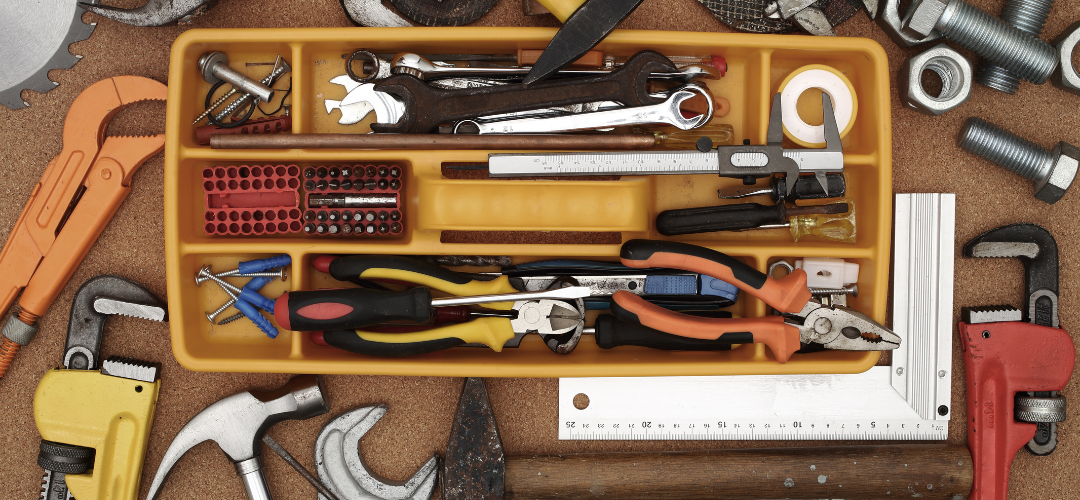Embarking on DIY projects can be both thrilling and fulfilling, but the key to a successful endeavor lies in having the right tools at your disposal. Whether you’re a seasoned DIY enthusiast or just dipping your toes into the world of do-it-yourself, building a well-equipped toolbox is the foundation for tackling projects with confidence and precision. In this in-depth guide, we will explore the essential tools that every DIY enthusiast should have, offering valuable insights into creating a versatile and efficient toolkit.
Power Tools: Empowering Your DIY Journey
1. Power Drill:
The power drill stands as the linchpin of any DIY toolkit. Whether you’re drilling holes or driving screws, a reliable power drill streamlines tasks and adds efficiency to your projects. Opt for a cordless drill for maximum versatility and ease of use, allowing you to move freely without the constraints of cords.
2. Circular Saw:
For cutting through various materials, a circular saw is indispensable. From plywood to lumber, a quality circular saw provides precision and speed, making it an essential tool for carpentry and woodworking projects. Its versatility allows for straight cuts and angled edges, expanding the scope of your DIY capabilities.
3. Jigsaw:
When it comes to intricate and curved cuts, a jigsaw is your go-to tool. Perfect for cutting shapes in plywood or creating custom designs, a jigsaw adds a versatile cutting option to your toolkit. Its maneuverability allows for detailed work, making it a must-have for DIY enthusiasts involved in crafting and bespoke projects.
4. Random Orbital Sander:
Achieving smooth finishes on your woodworking projects is a breeze with a random orbital sander. Its ability to remove material quickly while minimizing swirl marks makes it an invaluable tool for achieving professional-looking results. Whether you’re refining furniture or finishing a wooden surface, the orbital sander ensures a polished outcome.
5. Compound Miter Saw:
For accurate and angled cuts, a compound miter saw is a game-changer. Ideal for crown molding, baseboards, and framing, this tool enhances the precision of your cuts, ensuring seamless joints and corners. The compound miter saw opens up possibilities for intricate detailing in your projects, turning amateur endeavors into professional craftsmanship.
Hand Tools: The DIY Craftsman’s Companion
1. Screwdriver Set:
A versatile screwdriver set is a fundamental addition to your toolbox. Opt for a set that includes various sizes and types of screwdrivers to handle a range of tasks, from assembling furniture to tightening loose screws. The screwdriver set is the backbone of hand tools, offering flexibility for various applications.
2. Adjustable Wrench:
Tackling plumbing or furniture assembly? An adjustable wrench allows you to tighten or loosen nuts and bolts of different sizes, providing flexibility for various applications. Its adjustable jaws make it adaptable to a variety of fasteners, making it an essential tool for DIY projects requiring precision and efficiency.
3. Claw Hammer:
A claw hammer is a classic tool that every DIY enthusiast should have. Whether you’re driving nails or removing them, a quality hammer is essential for a variety of projects. The claw feature allows for easy nail removal, making it a versatile tool for carpentry, woodworking, and general home repairs.
4. Tape Measure:
Precision is key in DIY projects, and a reliable tape measure ensures accurate measurements. Look for a tape measure with both imperial and metric units for versatility. The tape measure is a simple yet crucial tool that forms the basis of precise measurements, guiding you through projects with accuracy.
5. Utility Knife:
A sharp utility knife is a must-have for cutting materials such as cardboard, foam, or drywall. Its versatility makes it an indispensable tool for precise and controlled cutting. Whether you’re scoring materials or making intricate cuts, the utility knife is a reliable companion for a range of DIY applications.
Measuring and Marking Tools: Precision in Every Detail
1. Combination Square:
Achieve precise angles and measurements with a combination square. This versatile tool is essential for ensuring accuracy in woodworking and other projects that require precise measurements. Its multi-functional design allows for measuring angles, depths, and marking straight lines.
2. Level:
A level is indispensable for ensuring that surfaces and installations are perfectly horizontal or vertical. Whether you’re hanging shelves or aligning tiles, a level is crucial for achieving professional-looking results. It provides a visual reference to ensure that your projects are not only accurate but also aesthetically pleasing.
3. Chalk Line:
For marking straight and level lines over long distances, a chalk line is a time-saving tool. Ideal for layout work and framing, a chalk line ensures accuracy in your projects. Its simplicity and efficiency make it a go-to tool for marking guidelines, enhancing the precision of your work.
4. Stud Finder:
Avoid surprises when hanging heavy items on your walls by using a stud finder. This tool helps locate studs behind drywall, providing a secure anchor for your fixtures and shelves. It’s a small but mighty tool that adds an extra layer of stability to your DIY projects, ensuring that your installations are secure and reliable.
Safety Gear: Prioritizing Your Well-Being
1. Safety Glasses:
Protect your eyes from dust, debris, and potential hazards with a pair of safety glasses. Whether cutting, sanding, or drilling, safety glasses are essential for maintaining eye safety during DIY projects. Investing in a comfortable and durable pair ensures that your eyes remain protected throughout your projects.
2. Ear Protection:
Power tools can generate significant noise, which may impact your hearing over time. Invest in quality ear protection to safeguard your hearing during prolonged or loud DIY tasks. Ear protection is a simple yet crucial element of safety gear, promoting long-term well-being as you engage in various DIY projects.
3. Dust Mask:
When sanding, cutting, or working with materials that produce dust, a dust mask is crucial for respiratory protection. Prioritize your health by wearing a mask that filters out particles and ensures clean air intake. A dust mask is a small investment that pays off in protecting your respiratory system from potential hazards in the workshop.
Shims and Packers: The Unsung Heroes of Stability
In the realm of DIY projects, achieving precision and stability is paramount. This is where shims and packers step in as unsung heroes, providing the necessary support to ensure your creations stand the test of time. Shims, often thin and wedge-shaped, are used to fill gaps and level surfaces, while packers, thicker and sturdier, support heavy loads and maintain alignment. Including these tools in your arsenal ensures that your projects are not just visually appealing but also structurally sound.
Shims:
- Versatility: Shims come in various materials, including plastic and wood, catering to different project needs. Plastic shims, for instance, offer moisture resistance and consistent dimensions, making them ideal for applications where durability and precision are crucial.
- Adjustability: The ability to make fine adjustments is a hallmark of shims. Whether you’re aligning doors, cabinets, or window frames, shims provide the flexibility needed to achieve a level and balanced result.
Packers:
- Load Support: Packers, being thicker and more robust, excel at supporting heavy loads. Whether you’re installing kitchen cabinets or levelling a deck, packers provide the stability needed to ensure your structures withstand the test of time.
- Material Choices: Packers are available in various materials, including plastic and composite options. The choice of material depends on factors such as load-bearing capacity and environmental considerations, ensuring you have the right packer for the job.
Building Your Versatile Toolkit: A Step-by-Step Guide
1. Assess Your Project Needs:
Before diving into tool selection, assess the types of projects you plan to undertake. Consider the materials you’ll be working with and the tasks involved to determine the essential tools for your toolkit. Including shims and packers in your assessment ensures that you have the support needed for precise and stable installations.
2. Establish Your Budget:
Building a toolkit is an investment, and establishing a budget helps prioritize essential tools. Consider the quality of tools over quantity, investing in durable and reliable options that will last. Allocate a portion of your budget to acquiring quality shims and packers, recognizing their role in enhancing the stability of your projects.
3. Prioritize Quality and Durability:
Quality tools ensure precision and longevity. Choose tools from reputable brands known for their durability and performance. A quality tool may cost more initially but pays off in the long run. Similarly, opt for shims and packers from trusted sources, ensuring they provide the stability and support required for your projects.
4. Consider Ergonomics:
Ergonomic design enhances comfort and reduces fatigue during extended use. Look for tools with ergonomic handles and features that promote user-friendly operation. This consideration extends to shims and packers, as easy handling and adaptability contribute to their effectiveness in achieving stability in your projects.
5. Organize Your Toolbox:
Once you’ve gathered your essential tools, organize them in a sturdy toolbox. A well-organized toolbox not only makes it easy to find the right tool but also helps maintain the longevity of your equipment. Designate a section for shims and packers, ensuring they are readily accessible when needed for your projects.
Conclusion: Empowering Your DIY Journey
Building your toolkit is a journey towards empowerment, creativity, and self-sufficiency. Each tool, from power drills to hand saws, plays a specific role in bringing your DIY visions to life. The addition of shims and packers elevates your toolkit, providing the essential stability and support needed for precise installations.
But beyond the tools, remember that safety gear and organizational habits contribute to the overall success of your DIY projects. Safety glasses, ear protection, and dust masks protect your well-being, ensuring you can enjoy your creations without compromising your health. A well-organized toolbox, including designated spaces for shims and packers, enhances efficiency and prolongs the life of your tools.
As you embark on your DIY journey, consider each tool as a brushstroke on the canvas of your creativity. Packers Direct, your trusted ally in the world of tools and accessories, stands ready to support your endeavors. Explore their extensive catalog to discover quality shims, packers, and other essential tools crafted for precision and durability.
So, arm yourself with the right tools, incorporate shims and packers into your toolkit, and dive into the world of DIY with confidence. Your projects are not just constructions; they are expressions of your creativity and capability.
Craftsmanship Meets Global Standards
Unlock Precision with ISO-Certified Excellence! Explore our Premium Range of Shims, Packers, and Plastic Moulding Today.






